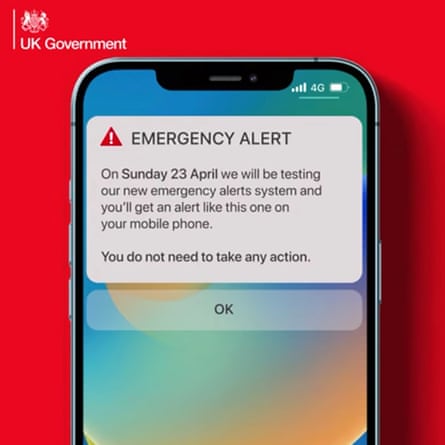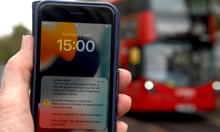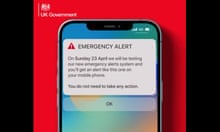There have been accusations of nanny statism, warnings from domestic abuse charities over inadvertently alerting abusers to hidden phones, and even pet shops cordoning off smaller animals so they don’t get frightened when the government’s emergency alert system is tested on Sunday at 3pm.
One thing is certain though: the UK government has taken its time in getting the system up and running, taking more than a decade to get to this first nationwide test.
When it first decided to send out an emergency alert in the first weeks of the national lockdown, it was forced to turn to mobile networks for help. Repurposing systems designed for adverts and service updates, the networks churned through users’ phone numbers sequentially, sending out tens of thousands of messages every minute.

But with millions of devices attached to the four main networks, it still took more than 48 hours for the alert to be delivered to every device. “The government went to the networks cap in hand,” said someone involved with those early discussions, “and was reliant on the networks sending it themselves without any real management on the throughput.”
The alerts were further limited by the technology of SMS messages, a decades-old service hacked together by Nokia engineers to hide text in the crevices of the wireless protocol that underpinned early mobiles: text only, limited to 160 characters and with no way of distinguishing between a legitimate sender and a conman. It ensured that the emergency alerts were almost immediately followed by a wave of “smishing” scams as fraudsters mimicked the tone to try to entice users to give up personal data.
Those failures came despite plans dating back over a decade for a national warning system. As early as 2013, the government was running trials across the country to test the possibility of using public phone networks to send emergency messages at a local or regional scale. The first such trials, in North Yorkshire, Glasgow and Suffolk, were deemed a success.
“Responders remain very keen to see the implementation of a national mobile alert system,” a 2014 report into the trials concluded. “The system would be an effective way of getting people to take specific protective action during an emergency. Whilst a significant challenge, there was consensus that it was possible to issue alerts to the public within 15 minutes of a decision being made.”
Instead, nothing happened, and when the government needed to issue an alert, it took almost 200 times as long to get the word out.

In the meantime, emergency alert systems became common in other countries. South Korea, the US and the Netherlands all have widespread cellular warning systems, while other nations including Germany and Japan have maintained older warning systems dating back to the cold war or earlier. A nationwide network of Warnämter air-raid sirens across Germany was demobilised in the 1990s after reunification, but reactivated a few years later amid growing concerns about terror attacks. Tens of thousands of the sirens are still in operation across the country, and are used to warn of extreme weather events or flooding.
In Japan, emergency broadcast systems are incorporated into daily life. The Bōsai Musen system consists of banks of loudspeakers mounted on poles in regions across the country, and in smaller towns and villages comes to life every day without fail, to play a collection of folk tunes known as the “5pm chime”. But that approach has been criticised: when the system was used for real in 2011, as a tsunami was bearing down on the country’s east coast, some ignored the warnings, apparently due to overexposure.
At the opposite end of the spectrum, America’s Federal Communications Commission takes a hard line on any attempt to trivialise its own emergency warning system. The “emergency alert system” can seize control of any TV or radio channel in the country, and plays a piercing sound of two simultaneous high-frequency tones. Distinctive and disruptive, the sound has been used in films, adverts and news broadcasts – and attracts six-figure fines each time it does, most recently in January when Fox used the illegal sound to advertise an NFL game. “The promotional segment’s ‘comedic tone’ also did not alter or neutralise its overall effect of falsely warning listeners and viewers of a nonexistent emergency,” the FCC said in dishing out the $500,000 penalty.
after newsletter promotion
Other aspects of America’s emergency broadcasting system have come under more criticism. Many Americans will know the text message alerts best not from emergency broadcasts, but from their incorporation into a system of “amber alerts”. Those warnings, sent out for missing children, have been criticised as “crime control theatre”, frequently issued too late to be helpful but still interrupting and alarming millions of recipients each time.
In the UK, the new alerts will be used for “life-threatening emergencies”, according to Oliver Dowden, the new deputy prime minister. The system has been built by Everbridge, a Boston-based company that already operates similar alerts in Estonia, Spain, Germany, Norway and Denmark.
It is not without criticism: former Tory cabinet minister Jacob Rees-Mogg accused the government of going “back to the nanny state”, and said he would turn the alert off on his phone. Pet store chain Jollyes has said it will cordon off pens to stop it startling small animals, and will warn customers ahead of the alert as they visit their stores.
There have also been warnings for people at risk of domestic abuse who have been advised to turn off any mobile device they want to keep hidden next Sunday. The government said people should follow the Refuge charity’s advice and switch off their devices or put them on airplane mode for the duration of the test.
On one metric at least, the UK is learning from the mistakes of those who came before it. The Florida Division of Emergency Management issued an apology on Thursday morning, shortly after a scheduled test for the statewide emergency alert system blared out of residents’ phones at 4.45am. “The division understands that unexpected 4.45 am wake-up calls are frustrating,” a spokesperson told the New York Times, “and would like to apologise for the early morning text.”










